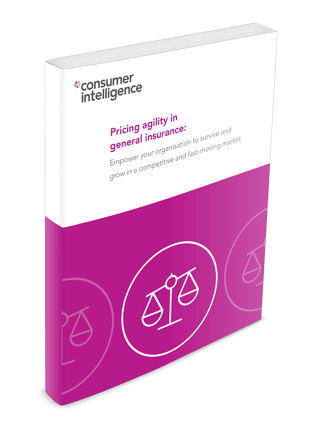
Following the recent announcement around the reduction of the Ogden discount rate the market has already seen many brands review their insurance pricing strategy to account for the greater claims costs they will face moving forward. At this early stage in March, Consumer Intelligence has already seen an increase in average car insurance prices of 2.2% since February and 4.1% since January.
In light of these changes the need to monitor your pricing has never been greater to ensure you are keeping your competitive edge as well as maintaining a profitable book of business.
We asked Phil Paterson-Fox one of the Key Account Directors here at Consumer Intelligence, what brands need to consider when developing their pricing strategy.
Q. Does the size of a business have an impact on its pricing strategy and use of data?
It's certainly true that bigger insurers are winning by using external data to gain a competitive advantage, and that's difficult to compete with because smaller insurers don’t necessarily have the resources to either buy the data in the first place and/or to analyse it. Insurance has always been about finding a pricing advantage; that's where the underwriters and actuaries earn their salaries! Data is what creates competitive advantage in the sector. So, if your competitors haven’t got access to the data you have, or haven’t interrogated the linkages between risks and that dataset, then that is going to drive competitive advantage.
Q. Do you think price is the only factor that matters when creating a strategy?
The importance of price varies by product sector but it is just one component of a pricing strategy .
We've been using the insurance benchmarking data we've built up to determine the brand strength of insurers. Combining that with pricing data enables our clients to be more informed about pricing action in the context of who's around them, especially on the aggregators.
We're then able to advise clients on price optimisation based on whether they need to be rank 1 or if they can still compete effectively from ranks 2-4 because the brands around them have weak brand strength versus their own. That drives optimal margins and volumes. Brand strength is important and should be factored into any strategy.
Q. How important is it to test your pricing strategy?
Price testing is a crucial part of any pricing strategy particularly where volume is a key objective. Some brands carry out price testing in the open market and that’s fine. However, there’s a real cost to this in terms of writing business at sub-optimal levels.
With access to the right data, you can test rates prior to putting them live. This is particularly relevant for brands distributing via aggregators where volume of quote traffic means any pricing errors are exposed very quickly - that is, unless you have incredibly flexible systems that allow you to change price almost immediately. Timely pricing data enables you to adapt and respond to market conditions providing valuable peace of mind and protection prior to putting a new set of rates live.
Some brands are focused more on margins and value than volume. In these cases, sticking to a core pricing methodology is certainly crucial. While price testing is therefore less important, being able to monitor your competitiveness within key sub-segments remains a key part of ensuring you’re not over-indexing due to pricing changes by competitors.
Q. Is understanding other insurers’ strategies just as important as your own then?
Yes - you take your eye off the ball at your peril!It's not just about the price that you're offering, but also the price your competitors are offering and the techniques and tools you can use to gain competitive advantage in the channels in which you're operating. But it's still important to stay focused on your own pricing strategy. It could be life threatening for a smaller insurer to get drawn into a battle with a bigger player with deep pockets prepared to operate at loss to meet volume targets. It's a 'dog eat dog world' out there where good data can make a significant difference to the effectiveness of your pricing strategy.
Whitepaper: Pricing Agility In General Insurance
The above “7 Steps to Pricing Agility” is an extract from our forthcoming Pricing Agility Whitepaper.
In this paper, we explore the current best practice in insurance pricing and give you some guidance about where the industry is about to go next.
Click here to download this exclusive whitepaper.




Submit a comment